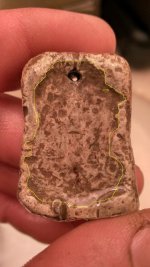detectorFRED
Full Member
- Dec 21, 2012
- 119
- 136
- Primary Interest:
- All Treasure Hunting
I have a 3 troy oz (92.1 g) silver pendent/gorget with what appears to be William Penn on the front and an elephant on the reverse side. Their are also many other little symbols carved into the sides, top and bottom. The symbols look similar to those that were found on the Lenape Stone found in Bucks County, PA. The piece stands straight up when placed on a counter-top, resembling almost a tombstone? The artifact measures 1.5" tall, 1.0" width and 0.5" thick (when added together equal 3, significant?) I tested the piece and it is 80-90% pure silver (Ag). On the bottom of the piece I can almost make out the numbers 43? Can someone please help me Identify this  Thanks!!!
Thanks!!!
 Thanks!!!
Thanks!!!Attachments
Upvote
0






















